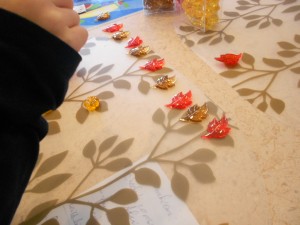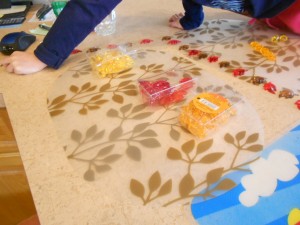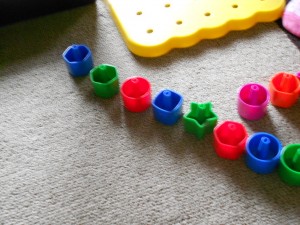The seasons follow a pattern, our days follow a pattern, our bodies and brains do too, so our play of the day is fall patterning math activities for kids.

Please don’t let the word math scare you away or cause any anxiety. There are no numbers to multiply or divide or problems to solve. This could be called fall patterning art activity. Either way it involves being creative and predictable at the same time.
We found some plastic fall leaves, acorns, and pumpkins at a dollar store. They were small enough for little hands and colorful enough to be interesting. First, I began a very simple, basic pattern: red leaf/gold leaf, red leaf/gold leaf. I showed Little Sister what I was doing. Of course, she wanted to do it too. She kept adding to the pattern all across the counter and then down. In math, this is called an AB pattern.
 When that pattern was done, I tried one more complicated using pairs: two pumpkins/two acorns, two pumpkins/two acorns. This is an AABB sequence, quite a bit more complicated. Little Sister looked at it but said it wasn’t a pattern. Her mind could see the simple one but wasn’t yet ready for something harder.
When that pattern was done, I tried one more complicated using pairs: two pumpkins/two acorns, two pumpkins/two acorns. This is an AABB sequence, quite a bit more complicated. Little Sister looked at it but said it wasn’t a pattern. Her mind could see the simple one but wasn’t yet ready for something harder.
Why is noticing and making patterns an important skill? Patterns reduce the burden of information from enormous amounts to chunks. If you look at the photo above of the leaves, instead of remembering the color and placement of 24 leaves, Little Sister only had to remember 2. Once she had red leaf followed by gold leaf she knew all of the others. Math certainly has patterns, but so does language. Music is based on patterns and so is art. In the grownup world, the economy follows a seasonal pattern and business people examine information in detail looking for patterns.

You don’t need leaves, plastic or real for fall patterning math activities. Patterns can be made with anything, like forks and spoons when unloading the dishes, or with toys. Block/car, block/car, could be an AB pattern sequence or blue/green/pink, blue/green/pink made with shapes. Kids may do this on their own and they are often quicker to see a pattern than adults. Another word for a pattern sequence is a routine. Is play part of the pattern of your child’s day?
